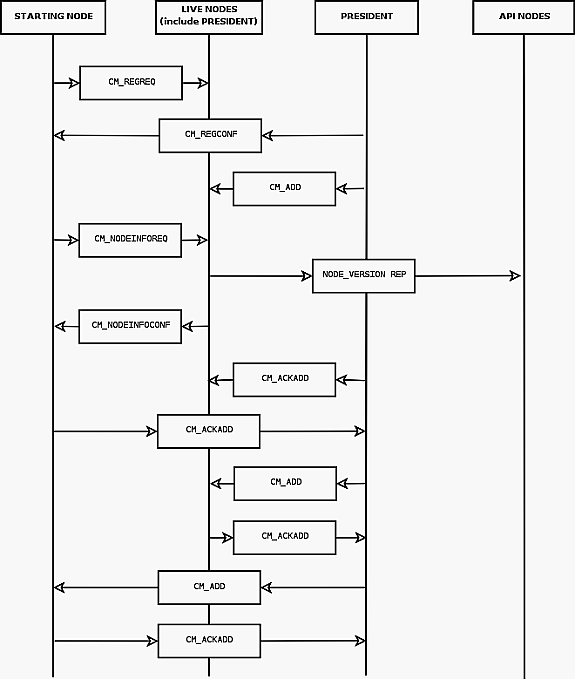- 6.5 MySQL Cluster Start Phases
- 6.5.1 Initialization Phase (Phase -1)
- 6.5.2 Configuration Read Phase (STTOR Phase -1)
- 6.5.3 STTOR Phase 0
- 6.5.4 STTOR Phase 1
- 6.5.5 STTOR Phase 2
- 6.5.6 NDB_STTOR Phase 1
- 6.5.7 STTOR Phase 3
- 6.5.8 NDB_STTOR Phase 2
- 6.5.9 STTOR Phase 4
- 6.5.10 NDB_STTOR Phase 3
- 6.5.11 STTOR Phase 5
- 6.5.12 NDB_STTOR Phase 4
- 6.5.13 NDB_STTOR Phase 5
- 6.5.14 NDB_STTOR Phase 6
- 6.5.15 STTOR Phase 6
- 6.5.16 STTOR Phase 7
- 6.5.17 STTOR Phase 8
- 6.5.18 NDB_STTOR Phase 7
- 6.5.19 STTOR Phase 9
- 6.5.20 STTOR Phase 101
- 6.5.21 System Restart Handling in Phase 4
- 6.5.22 START_MEREQ Handling
This is one of the phases in which most kernel blocks
participate (see the table in
Section 6.5.3, “STTOR Phase 0”).
Otherwise, most blocks are involved primarily in the
initialization of data — for example, this is all that
DBTC does.
Many blocks initialize references to other blocks in Phase 1.
DBLQH initializes block references to
DBTUP, and DBACC
initializes block references to DBTUP and
DBLQH. DBTUP initializes
references to the blocks DBLQH,
TSMAN, and LGMAN.
NDBCNTR initializes some variables and sets
up block references to DBTUP,
DBLQH, DBACC,
DBTC, DBDIH, and
DBDICT; these are needed in the special start
phase handling of these blocks using
NDB_STTOR signals, where the bulk of the node
startup process actually takes place.
If the cluster is configured to lock pages (that is, if the
LockPagesInMainMemory configuration parameter
has been set), CMVMI handles this locking.
The QMGR block calls the
initData() method (defined in
storage/ndb/src/kernel/blocks/qmgr/QmgrMain.cpp)
whose output is handled by all other blocks in the
READ_CONFIG_REQ phase (see
Section 6.5.1, “Initialization Phase (Phase -1)”).
Following these initializations, QMGR sends
the DIH_RESTARTREQ signal to
DBDIH, which determines whether a proper
system file exists; if it does, an initial start is not being
performed. After the reception of this signal comes the process
of integrating the node among the other data nodes in the
cluster, where data nodes enter the cluster one at a time. The
first one to enter becomes the master; whenever the master dies
the new master is always the node that has been running for the
longest time from those remaining.
QMGR sets up timers to ensure that inclusion
in the cluster does not take longer than what the cluster's
configuration is set to allow (see
Controlling
Timeouts, Intervals, and Disk Paging for the relevant
configuration parameters), after which communication to all
other data nodes is established. At this point, a
CM_REGREQ signal is sent to all data nodes.
Only the president of the cluster responds to this signal; the
president allows one node at a time to enter the cluster. If no
node responds within 3 seconds then the president becomes the
master. If several nodes start up simultaneously, then the node
with the lowest node ID becomes president. The president sends
CM_REGCONF in response to this signal, but
also sends a CM_ADD signal to all nodes that
are currently alive.
Next, the starting node sends a
CM_NODEINFOREQ signal to all current
“live” data nodes. When these nodes receive that
signal they send a NODE_VERSION_REP signal to
all API nodes that have connected to them. Each data node also
sends a CM_ACKADD to the president to inform
the president that it has heard the
CM_NODEINFOREQ signal from the new node.
Finally, each of the current data nodes sends the
CM_NODEINFOCONF signal in response to the
starting node. When the starting node has received all these
signals, it also sends the CM_ACKADD signal
to the president.
When the president has received all of the expected
CM_ACKADD signals, it knows that all data
nodes (including the newest one to start) have replied to the
CM_NODEINFOREQ signal. When the president
receives the final CM_ACKADD, it sends a
CM_ADD signal to all current data nodes (that
is, except for the node that just started). Upon receiving this
signal, the existing data nodes enable communication with the
new node; they begin sending heartbeats to it and including in
the list of neighbors used by the heartbeat protocol.
The start struct is reset, so that it can
handle new starting nodes, and then each data node sends a
CM_ACKADD to the president, which then sends
a CM_ADD to the starting node after all such
CM_ACKADD signals have been received. The new
node then opens all of its communication channels to the data
nodes that were already connected to the cluster; it also sets
up its own heartbeat structures and starts sending heartbeats.
It also sends a CM_ACKADD message in response
to the president.
The signalling between the starting data node, the already “live” data nodes, the president, and any API nodes attached to the cluster during this phase is shown in the following diagram:

As a final step, QMGR also starts the timer
handling for which it is responsible. This means that it
generates a signal to blocks that have requested it. This signal
is sent 100 times per second even if any one instance of the
signal is delayed..
The BACKUP kernel block also begins sending a
signal periodically. This is to ensure that excessive amounts of
data are not written to disk, and that data writes are kept
within the limits of what has been specified in the cluster
configuration file during and after restarts. The
DBUTIL block initializes the transaction
identity, and DBTUX creates a reference to
the DBTUP block, while
PGMAN initializes pointers to the
LGMAN and DBTUP blocks.
The RESTORE kernel block creates references
to the DBLQH and DBTUP
blocks to enable quick access to those blocks when needed.
